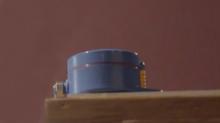Temperature and Relative Humidity
What you will need:

Transcript
Getting started
I am going to talk to you about monitoring temperature and relative humidity in your collection space to prevent damage caused by poor environmental conditions.
Relative humidity, or RH, measures the amount of water vapour in the air at a particular temperature. When a volume of warm air is cooled, its RH goes up. When a volume of cool air is warmed, its RH goes down.
The recommended environmental conditions for a mixed item collection is a RH of 50 ± 5%, and a temperature of 20 ± 2 °C.
Stable conditions
Do not be too concerned if you cannot achieve these conditions in your space, but try to maintain stable conditions as close as possible to these recommended values.
It is often the fluctuations in RH that cause more damage than having a constantly high or low relative humidity.
More rigid materials like wood are particularly vulnerable to cracking during sudden relative humidity changes.
Different components of composite objects may release moisture at different rates, causing loosening of the bonds between them. Veneers and inlays are particularly susceptible to changes in RH.
Low humidity
A prolonged low relative humidity can cause shrinkage and desiccation of organic materials, leading to cracking and embrittlement.
High humidity
Very high relative humidity levels can cause damage to your collection in several ways, including:
- Corrosion of metals.
- Fading of dyes and textiles.
- Swelling and distortion of organic materials.
- Increased likelihood of insect activity.
- Gelatine emulsions on photographs and adhesives become sticky and attract dust.
- Mould growth if RH levels go above 70%, especially when there is poor air circulation.
High temperatures
Temperature is usually not as critical as relative humidity in the protection of objects, however a high temperature can:
- Increase the rate of most chemical reactions causing deterioration.
- Contribute to dimensional changes and desiccation.
- Soften resins, waxes and adhesives that can then attract dust.
- Increase biological activity such as moulds and insects.
Having an unsuitable temperature will also inevitably affect the RH.
Measuring environmental conditions
There are several ways to measure relative humidity.
Environmental monitors measure relative humidity, temperature, visible light and UV radiation in one unit. These are convenient but will need to be calibrated regularly.
Although you can buy cheaper dials or electronic hygrometers to measure the relative humidity, these are much less accurate.
Measuring throughout the day
RH can vary greatly over the course of a day, or depending on the weather conditions. In order to measure changes over time, you will need either a paper based thermo-hygrograph or a data logger.
Air conditioning
Major museums operate 24-hour HVAC air-conditioning systems that control both the temperature and relative humidity to within tight parameters. Many smaller museums have domestic air-conditioning units that control the temperature but not the relative humidity. They are often not suited to 24-hour use and costs may be prohibitive. There may be large relative humidity swings when the units are switched on in the morning and off at night. Recording what is happening in your building is important in order to understand what is happening to your collection.
Handy hints
- Having a well maintained, sealed and insulated building is a cost effective means of stabilising humidity and temperature.
- Some buildings will always be vulnerable to leaking and should be carefully inspected during times of heavy rain. Any leaks should be dealt with as quickly as possible.
- Keep doors and windows closed as much as possible.
- Sensitive objects should not be displayed on exterior walls, and should be kept away from sources of humidity such as kitchens and toilets.
- Dehumidifiers and humidifiers might be useful in circumstances where there is a constantly high or low relative humidity. Their effect on the relative humidity should be closely monitored. Note that portable dehumidifiers contain chambers, which fill with water and must be regularly emptied. Humidifiers produce steam and should be kept out of reach of visitors, and not placed close to museum objects.
- A well-sealed bag, display case or box can slow down environmental change within. This is referred to as a microclimate. In addition, adding hygroscopic materials such as acid-free mount board, acid-free tissue or washed cotton to storage containers will help stabilise the RH by absorbing or giving off moisture as required.
- Desiccants such as Artsorb and Rhapid gel can be used to control the RH within a display case where there are particularly sensitive and significant objects. These materials require regular reconditioning and only work in a well-sealed case.
By following these steps you will be able to measure and control the relative humidity and prevent damage in your collection space.
Thanks for listening.












